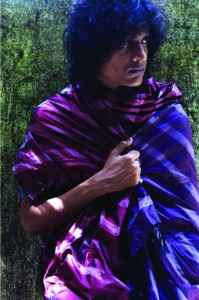My formal training in design came from a four-and-a-halfyear course at the Srishti School of Art, Design and Technology, Bangalore. What helped me grow beyond an institute were the various people I worked under and my family of artisans. The birth of my first line came from the idea that I had so many wonderful and talented artisans around me. I wanted to collaborate with them, marry their traditional skills to a contemporary design and colour palette and project it anyone who was interested. We work as a team of equals, and this achievement makes me very proud. It breaks barriers of religion, sex, region and colour.
I also believe in fair trade, that my artisans must get their due. My goal is to expand my team of artisans and work to find markets for artisans who are less fortunate than their peers.
What are the skills you need to have to be a textile designer?
In order to be a textile designer, you need to have a deep understanding of your line of interest. If it is industrial textiles, then you must know the technical workings of a power loom to understand the design possibilities. It also helps if you love your work – my inspiration comes from handcrafted textiles found in India. It is very old world, deep and meaningful.
I had always been interested in handmade fabrics and motifs. I found that my way to gain knowledge was to travel and explore my options. I worked at Khamir, an NGO at Kutch; interned with Abraham & Thakore and worked at a small boutique in Bangalore, Iksenya. During these periods, I had the good fortune to be able to travel and meet artisans all over India. It helped me network and continue studying textiles. With textiles, you can only study so much; it is all about being hands on. Whether it is assisting your artisan with a clamp-dyeing technique, taking notes while he shows you ancient borders and patterns, or listening to the wisdom that a mentor brings; this route continues to be an eye-opener.
It helps when designing patterns to revisit your inspirations – be it a paper, notes from a course or even a film. During my time in design school, I experimented with everything from law, creative writing, weaving, and graphic designing to film appreciation! It gave me a broader canvas and all these subsets of design have become my brand tools today.
 What are the challenges faced by textile designers in India?
What are the challenges faced by textile designers in India?
The traditional textiles that we have in this country are simply breathtaking. One of the challenges we face in India is that we sometimes take this variety and skill for granted. On a global level, Indian textiles are looked at with such amazement and regard. Textile designers come here and study under our artisans to unearth centuries of wisdom. We should be greedy for this knowledge as it lies right in front of us!
It is important to be aware of your strengths and weaknesses and work on them. My strengths were in colour theory, weaving and writing; I was terrible at drawing so I opted for graphic design courses in layout and composition, which helped me visualise my fabrics.
Copyright doesn’t exist in design so if your design gets copied, be flattered. Plus, as a lawyer once told me – if someone copies your design, there are high chances of you churning out another 100 good designs that the person cannot replicate! Use that to your advantage.
Setting up your own practice is not easy – whichever field you are in. Be patient. It helps to step out, make contacts and inspire yourself. When design becomes a part of you, it becomes a way of life. You see colour combinations in your chai and biscuit. You hear someone use an interesting word and it triggers a design concept. The list is endless!
“Design is like music: the more you practice, the better you get at it.”
Volume 1 Issue 12






























